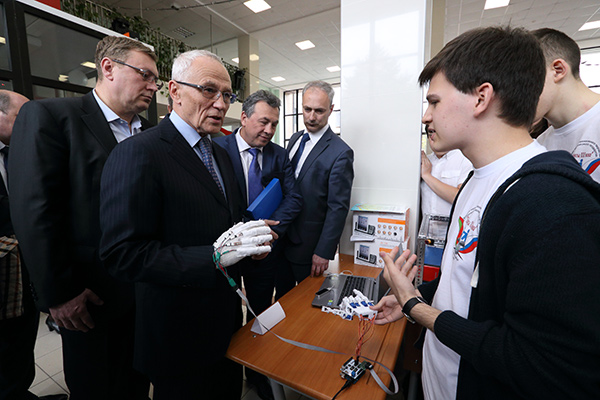
Speaking of contestants’ works, the State Secretary of the Union State, Grigory Rapota, noted that many talented children live in Belarus and Russia. “We’re delighted by our youngsters’ passion for science and engineering. They penetrate to the heart of problems. Among the projects are many truly interesting ideas worthy of joining serious science, owing to their significance. Some are already patented. As regards prospects, our winners are sought by universities and tend to have no problem enrolling. Moreover, it’s great to know that so many boys and girls are professionally oriented — being aware of what they’d like to do in their adult life. Sadly, some regions fail to create conditions for these children to realise their capabilities; it’s an important aspect. Contestants from Kabardino-Balkaria worthily rival Minskers and others: for several years, they’ve entered the 21st Century Talents finals, thanks to their region encouraging children in a love for science and engineering. This is great. I’m convinced that forums of this kind must be promoted. Our task is to assist young inventors in finding their way, for the benefit to the state’s future,” he underlines.
The contest is a Union State project but Mr. Rapota hopes other Eurasian Union member states will participate in future. “The contest would benefit,” he notes, adding, “We’re trying to attract as many participants from Russia and Belarus as possible, because there’s potential for more entrants. Since 2009, the number of finalists has reached 2,000 and their geography is set to expand.
The St. Petersburg exhibition of finalists featured a miniature border motor-boat, which won the ‘Technical Modelling’ nomination. Designer Roman Knyrev, from Orsha, commented, “I’m trained by my father, who is a boat maker. This victory is valuable, since I plan to enter an engineering department. I’m already building a new model: of a submarine.”
Polina Pomogaeva, from Kabardino-Balkaria, won the ‘Video Film’ nomination. She explains, “The jury were surprised to discover that I’d collected so many materials on my countryman: academician and laureate of numerous awards, Timur Eneev. He has achieved much for the space sphere, having helped develop the legendary R-7 rocket. A small plant is named after him.”
The jury were also much pleased and impressed by a robot-vacuum, which not only cleans but scans for hazardous gases, smoke, fire and mercury vapour, calling the rescue service or its owner. The device can report on the weather and remind of favourite recipes, as well as bring slippers and turn off the iron! The invention is the work of tenth grade pupil Alexander Dubovistky, from Minsk.
Just as intriguing is an invention by Mogilev’s Ilya Shubin: a 3D printer for inscriptions on chocolate; it can even create portraits. The idea would surely appeal to confectionaries. St. Petersburg’s Sergey Lappo demonstrated his device to safely send text messages, while Yegor Zhumikov (from Crimea) showed his road safety software, which forces a car to stop for pedestrians. Other projects included simulators for ballistic rockets and a mobile industrial complex for mining gelium-3 on the Moon, in addition to alternative energy sources.
Some might treat children’s inventions with scepticism, saying they’re unlikely to create a technical revolution. However, Steve Jobs and Steve Wozniak created their first personal computer in the garage in the 1970s: a true engineering miracle. Inquisitive minds and a desire to invent drive forward science and technologies.
The Head of Machine Building Technology at the Belarusian National Technical University, Valery Sheleg, who is a corresponding member of the National Academy of Sciences, tells us, “I believe that contests of this kind are a long-term investment; we’ll see our returns in 10-20 years’ time. Many of these guys are through to the finals not for the first time and, each year, the level of projects is enhanced, with more intellectual ideas demonstrated. Importantly, these children are occupied and have an outlet for their energies and talents. They are our future. Of course, they won’t all become employed in the field of science but, even if one or two percent do, it’s an achievement for our forum. In Belarus, the top three youngsters automatically join the list of talented youth, receiving scholarships. Meanwhile, the winners have the right to enter Belarusian higher educational establishments without any further entry requirements. The Russians may also follow suit at some point.”
An academician of the Belarusian National Academy of Sciences, Piotr Vityaz, is convinced that such events encourage patriotism. He notes, “These children speak of their developments with great enthusiasm and passion. It’s important to help them reach the goals. One boy, from St. Petersburg, told me that he’d love to become a cosmonaut but has poor health; as a result, he’s decided to become a space engineer. There are many such talented and enthusiastic children.”
The General Director and General Designer of Russia’s Morinformsistem-Agat Concern has no doubt that some contestants’ ideas are suitable for use by scientific-production associations’ practical application. “Following the exhibition of finalists, I have a collection of calling cards. Just now, I’ve talked to a boy from Gomel who has developed an air pillow; his invention uses an interesting aerodynamic scheme of air-flow distribution. I’ve invited him to visit a Russian aero-hydrodynamics enterprise during his holidays. I’m also impressed by the work of Darya Bereichuk, a 10th grade pupil from Rostov Region. Her district lacks a physics teacher so she’s developed e-teaching aids on the subject, in addition to a model pendulum (to demonstrate oscillation processes). This year, Dasha’s project was awarded the first place at the Russian contest. In turn, a boy from Penza Region has invented a measuring device for resistance and generator frequency, for use by university and college laboratories and small workshops. Enterprises should be interested in offering scientific support, gathering inventors who can bring benefit to the state,” he emphasises.
By Lyudmila Gladkaya











